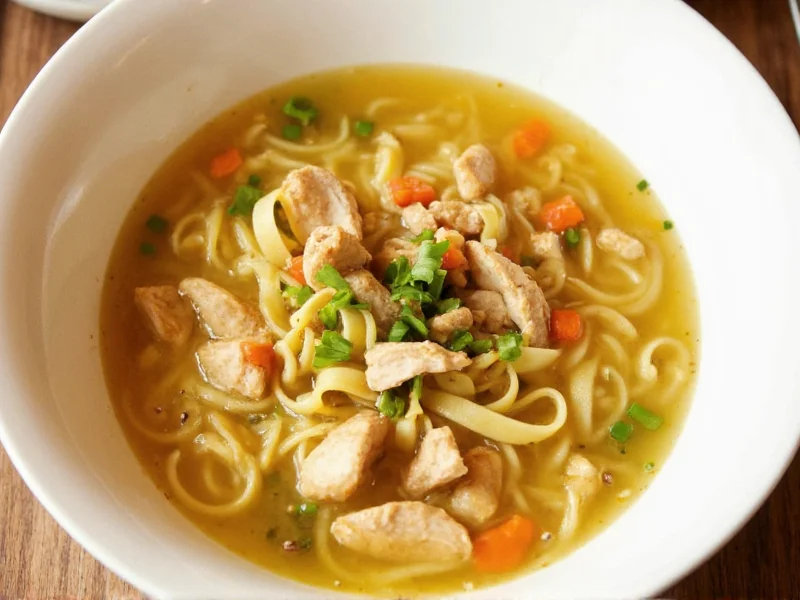Understanding Panera's Chicken Noodle Soup Composition
When examining Panera's chicken noodle soup ingredients list, you'll find a straightforward combination of recognizable components. The soup contains chicken broth, cooked chicken breast meat, egg noodles (wheat flour, egg, niacin, iron, thiamin, riboflavin, folic acid), carrots, celery, and seasonings. Unlike many canned alternatives, Panera's version avoids artificial additives while maintaining a comforting flavor profile that has made it a consistent menu staple since the chain's early days.
Nutritional Profile Analysis
For health-conscious consumers evaluating panera chicken noodle soup nutrition facts, the numbers present a balanced option among restaurant soups. A standard 10.75-ounce serving provides:
| Nutrient | Amount per Serving | % Daily Value |
|---|---|---|
| Calories | 140 | 7% |
| Total Fat | 3.5g | 4% |
| Sodium | 860mg | 37% |
| Total Carbohydrates | 16g | 6% |
| Protein | 7g | 14% |
The sodium content represents the most significant nutritional consideration when ordering panera classic chicken noodle soup. While the protein content provides reasonable satiety, those monitoring sodium intake should be aware that one serving contains over one-third of the recommended daily maximum. The soup contains no trans fats and minimal saturated fat, making it a relatively heart-healthy option among restaurant soups.
Taste and Texture Evaluation
Professional food analysts and regular customers consistently note panera bread chicken noodle soup's balanced flavor profile. The broth delivers a clean chicken flavor without excessive saltiness that often characterizes commercial soups. Shredded white meat chicken appears in generous portions, while the egg noodles maintain their structure without becoming mushy—a common issue in reheated soups. The vegetables retain slight firmness, suggesting minimal overcooking during preparation.
When comparing panera chicken noodle soup vs homemade versions, the restaurant's offering holds its own in convenience while sacrificing some depth of flavor. Homemade versions typically develop more complex broth through long simmering of bones and aromatics, while Panera's soup prioritizes consistency and food safety standards required for commercial preparation.
How It Compares to Other Restaurant Options
Among popular casual dining chains, Panera's chicken noodle soup occupies a middle ground in both quality and nutritional profile. When evaluated alongside competitors:
- Chick-fil-A: Their version contains more sodium (940mg) but slightly less calories (120)
- Chipotle: Offers a chicken tortilla soup rather than traditional chicken noodle
- Subway: Their version has comparable calories but higher sodium content (960mg)
- Homemade standard recipe: Typically lower in sodium but varies significantly based on preparation method
For those specifically searching is panera chicken noodle soup healthy, the answer depends on dietary priorities. It provides moderate protein with minimal fat, but the sodium level may concern those with hypertension or on sodium-restricted diets. The absence of artificial ingredients and preservatives represents a quality advantage over many canned grocery store alternatives.
When Panera's Soup Makes Sense
Certain situations make panera chicken noodle soup nutrition facts particularly relevant for decision-making:
- Quick lunch option when seeking something warm and moderately nutritious
- When traveling and needing a familiar, consistent meal option
- During cold and flu season as a comforting, hydrating option
- For those avoiding artificial ingredients found in many canned soups
The soup's 140-calorie profile makes it suitable as a light lunch when paired with a side salad, though the sodium content warrants consideration for regular consumption. Those specifically monitoring panera chicken noodle soup calories as part of weight management should note that ordering it as a side rather than main course significantly reduces caloric intake.
Considerations for Special Dietary Needs
For customers with specific dietary requirements, Panera's chicken noodle soup presents both advantages and limitations:
- Gluten sensitivity: Contains egg noodles made with wheat flour
- Low-sodium diets: 860mg sodium may exceed restrictions
- Protein needs: 7g provides moderate protein content
- Allergens: Contains wheat, egg, and chicken
While not designed as a health-focused product, panera classic chicken noodle soup represents a better-than-average restaurant soup option when evaluating ingredient quality and nutritional balance. Those seeking panera chicken noodle soup ingredients list details can find complete information on their official website, which breaks down each component for transparency.
Final Assessment
As a regular menu item at Panera locations nationwide, their chicken noodle soup delivers consistent quality that has maintained customer loyalty. While not identical to carefully prepared homemade versions, it offers a convenient alternative that avoids many pitfalls of commercial soup production. The balance of recognizable ingredients, reasonable nutrition profile, and comforting flavor makes it a solid choice among restaurant soup options, particularly for those prioritizing ingredient transparency over ultra-low sodium content.











 浙公网安备
33010002000092号
浙公网安备
33010002000092号 浙B2-20120091-4
浙B2-20120091-4